BA Birds
GO TOP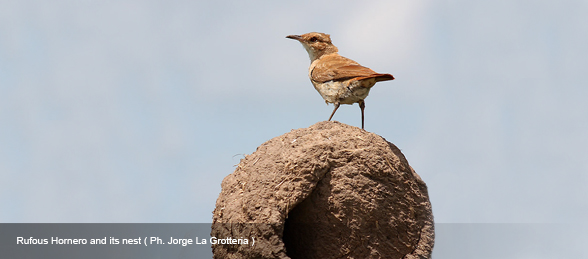
Downtown species
About 20 species of birds can be commonly seen in downtown Buenos Aires and the many parks and squares of the city. The availability of food and water makes it a very attractive place to live for some generalist species. Among them, doves and pigeons are the most abundant ones, such as the Picazuro Pigeon, Eared Dove, Picui Ground-Dove and the very common exotic Rock Pigeon. Thrushes are common too, with two species in the city: Rufous-bellied and Creamy-bellied Thrushes. During the spring season, the beautiful song of the first one can be heard from very early in the morning (sometimes too early), far before sunrise. Rufous Hornero, Argentina’s national bird, it’s a very remarkable bird despite of its plain brown plumage. The Spanish word “Hornero” means “oven maker”, and comes from the shape of its nest, that looks like a mud oven. They build a new one every season, and the old ones are used by other species of birds, making the Hornero a very important bird in the areas that inhabits. Some of the species that take advantage of the Honero’s old nests are other common city birds such as the exotic House Sparrow, but also some native ones like swallows and martins, such as the White-rumped Swallow and the Brown-chested Martin. They arrive in the spring and spend all the summer season in the area, before migrating back again to their wintering territories in the north. Another migrating martin that breeds in the city, although preferring holes in buildings rather than old Hornero’s nests, is the Gray-breasted Martin, probably the most common martin in BA downtown during the summer.
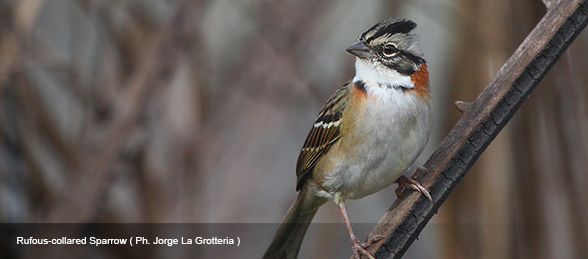
The Great Kiskadee, the common Rufous-collared Sparrow, Shiny Cowbird, Chalk-browed Mockingbird and many others are also among the most common city birds in Buenos Aires.
In the last few years one species of recently introduced bird has became very abundant in the area: the European Starling. This is a real problem for native species because it competes with them for food and space. As an example, it usually steals the nests of the Green-barred Woodpecker (still findable in the city), even if their are active with chicks inside.
Some raptors are also common in the city, some of them being more likely to be seen in the city center or neighborhoods than in the nature reserves. The Peregrine Falcon is one of this species. Although not abundant, it has made of the tall buildings of downtown Buenos Aires its new habitat during their non breeding season (it’s a migrant). A more common bird of prey in BA is the gregarious Harris’s Hawk, (or Bay-winged Hawk, as its local subspecies was formerly called). Pairs and groups of this bird can be seen in almost every park of the city. The Southern Caracara and Chimango Caracara (probably the most abundant Argentine raptors) are also very common in the city. Both are opportunistic birds and mainly scavengers, but the first one is also a good hunter. This is well known by the pigeons, that are not comfortable with their presence whenever they show up. Other raptors that use the city parks as a hunting ground are the Roadside Hawk and the American Kestrel.
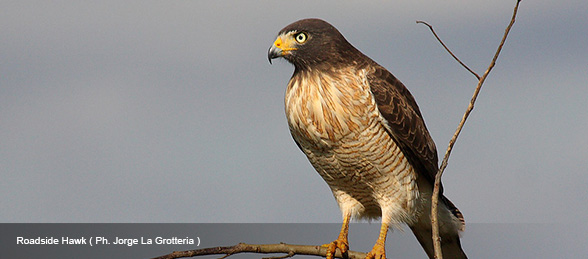
Parakeets and parrots deserve a special paragraph in this city birds description. Buenos Aires city has an astonishing very high diversity of parrots and parakeets, with more than 10 species recorded. To say the truth, hardly two of them can be cited as original from these latitudes, and the origin of the rest (although some of them might have come by their own) is related to escaped specimens from captivity and release events. In any case all of them are native to Argentina. Both original and new species have adapted very well to the city’s conditions, and have found sources of food. The extremely common Monk Parakeet is one of the original species, and can be easily seen even nesting in their enormous group nests on trees in parks and squares. Of the new residents, four interesting species can be watched on a walking tour in the city: White-eyed Parakeet, Nanday Parakeet (formerly called “black-hooded parakeet”), which is now almost as common as the Monk Parakeet in some areas of the city, the Maroon-bellied Parakeet and Yellow-chevroned Parakeet. They all have different behaviors and can be recognized even without seen them, because of their particular voices and sounds.
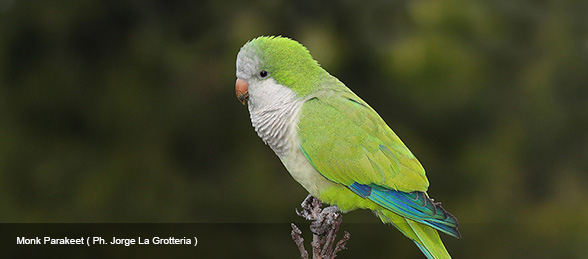
White-eyed Parakeet and Reddish-bellied Parakeet are more frequent in parks and streets than in the reserves. And the Canary-winged Parakeet is more common on the sub-urban surrounding area of Buenos Aires and some parks inside of the city, where its frequently seen feeding on the seeds of the Silk Floss Tree (Ceiba speciosa), called “Palo Borracho” in Spanish, whose original habitat (north-east Argentina) constitutes the same of the parakeet's. Other interesting species include the Turquoise-fronted Parrot, Mitred Parakeet and Green-cheeked Parakeet.
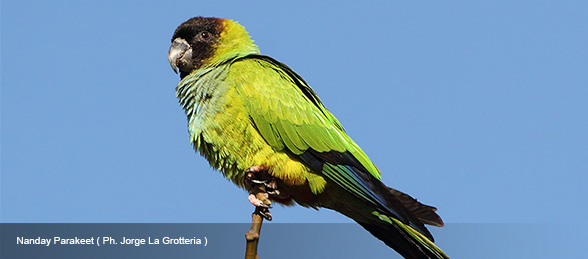
Species restricted to particular habitats
As described in Buenos Aires Wildlife section, the different habitats of this part of Argentina are diverse and most of them are represented in the city’s urban reserves and other spots not too far from it, such as Otamendi or Punta Lara reserves. Following, some of these habitats are mentioned with the most remarkable species of each that can be found in the city and surroundings.
Riverside & Espinal forests
These two native forests are home for very interesting species. Many of them share both habitats, and some have adapted to the new landscape, living even in exotic-tree constituted forests (or plantations). But some of them are very restricted to their native ecosystems, and can not be found anywhere else.
The Riverside forest is the most biodiverse habitat in Buenos Aires province. Thus, this also applies to birds too. Some of its specialties include the Spix’s Spinetail, Rufous-capped Antshrike, Mottled-cheeked Tyrannulet, Diademed Tanager, Gray-throated Warbling-finch, Golden-crowned Warbler, Solitary Black Cacique and Green-winged Saltator. Although some of them are also found in other habitats elsewhere on their range, they all find their southernmost distribution limit in this area of Buenos Aires, where they are almost reclusive to this kind of forest.
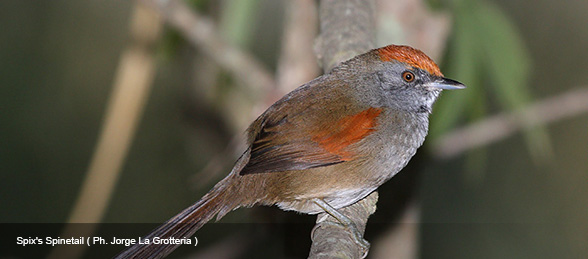
The Espinal forest, although usually considered as an impoverished chaco forest, does not deserve such appellative since its very rich diversity of birds. Among its specialties are the Tufted Tit-spinetail, Freckle-breasted Thornbird, White-tipped Plantcutter, Masked Gnatcatcher, Ultramarine Grosbeak Golden-billed Saltator and Grayish Saltator.
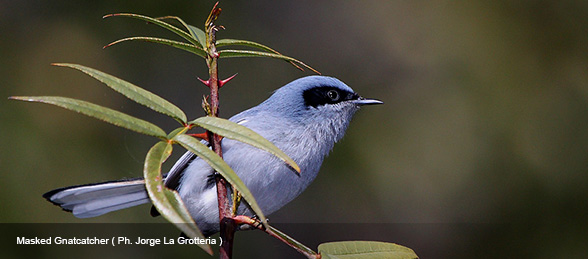
Some of the many other species that share these two types of forest in Buenos Aires area are the White-tipped Dove (very common, although much more easy to hear than to see), Checkered Woodpecker, Narrow-billed Woodcreeper, Sooty-fronted Spinetail, Rufous-browed Peppershrike, Sayaca Tanager, Blue-and-yellow Tanager, Red-crested Cardinal, Epaulet Oriole, and some summer visitors such as the White-winged Becard, Streaked Flycatcher, Swainson’s Flycatcher and Bran-colored Flycatcher.
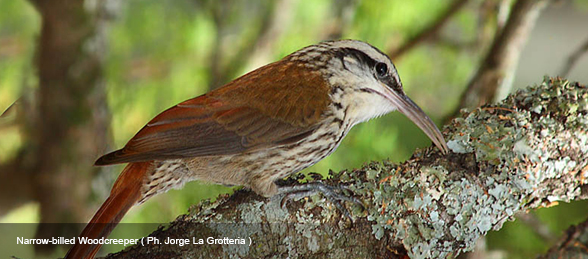
Marshes, water streams and lagoons
In the marshes and lagoons of the area, depending on the water level (which also depends on the rain that has fallen during the year) many species of aquatic birds can be easily watched: more than 15 species of ducks and relatives live and even (not all of them) breed here.
The two South American swans, Coscoroba Swan –although it is closer to guise than to real swans– and Black-necked Swan, Southern Wigeon, White-faced Whistling-Duck, Silver Teal, Brazilian Duck and Ringed Teal are just a few examples of this group of birds. Coots and Gallinules are as common as most of the ducks named before, being the Red-gartered Coot, White-winged Coot, Red-fronted Coot, Common Gallinule and Spot-flanked Gallinule the most frequent species in the area. Egrets and herons are abundant too with Cocoi Heron, Great Egret, Snowy Egret, Striated Heron and Black-crowned Night-Heron as some of the most common species. The Rufescent Tiger-Heron is the most remarkable species in the area.
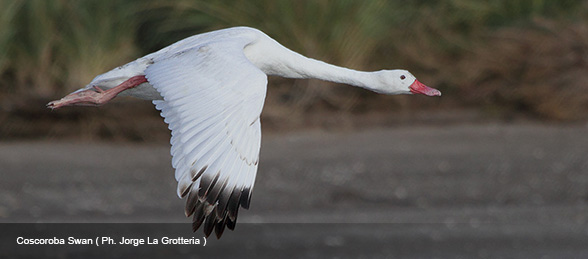
Other common aquatic birds are the ibises like the Bare-faced Ibis and White-faced Ibis; the Neotropic Cormorant, some Grebes such as the White-tufted Grebe and the Pied-billed Grebe; and the Limpkin.
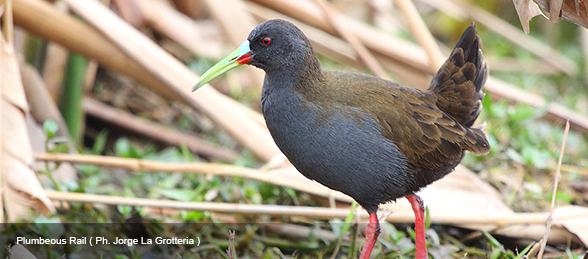
Rails and Crakes are part of Buenos Aires water-related birds. A special mention deserve the Giant Wood-Rail and the Grey-necked Wood Rail. Both are large rails, not very reclusive compared with most of the other members of this group. The late species is very much associated to the riverside forest. Plumbeous Rail is a common species in the area, although not easy to see. Crakes are among the most interesting marsh birds (by the way, Birding Buenos Aires’ logo is a Crake). In the city area, the Rufous-sided Crake is the most likely to spot. A beautiful bird, although very small and reclusive, it’s much more easy to hear than to see. In Punta Lara and Otamendi areas, the scarce Red-and-white Crake is also a possibility, and in the last place there is also a population of the very rare and almost endemic Dot-winged Crake.
Other birds related to these water ecosystems are the Snail Kite (a bird of prey highly specialized which feeds almost solely on water snails, using its hook-like beak to take the soft part of the snail out of the shell) and three species of kingfishers, Ringed Kingfisher, Green Kingfisher and Amazon Kingfisher. The last species is the least common.
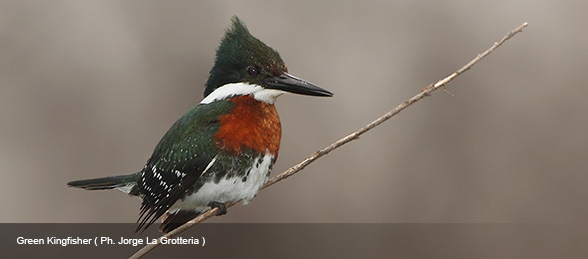
The list wouldn’t be complete without mentioning some passerines (sparrow-like birds) strongly related to the marshes: Wren-like Rushbird, Sulphur-bearded Spinetail, Yellow-throated Spinetail, the Many-colored Rush-Tyrant and the Warbling Doradito. These species sole habitat is the reed on lagoons, marshes and other aquatic ecosystems. Other passerines that inhabit these kinds of environments are the Spectacled Tyrant, Sooty Tyrannulet and the blackbirds: Chestnut-capped Blackbird, Yellow-winged Blackbird, Unicolored Blackbird and the declining Scarlet-headed Blackbird.
A different ecosystem although very related on its bird fauna is the coast of La Plata River, which is the best place to see some aquatic species such as the Neotropic Cormorant (already named before) and the Great Grebe, Kelp Gull, Gray-hooded Gull, Brown-hooded Gull and the Snowy-crowned Tern. In the winter this is also the best place in BA for finding an Olrog’s Gull, an endangered species almost endemic to Argentina.
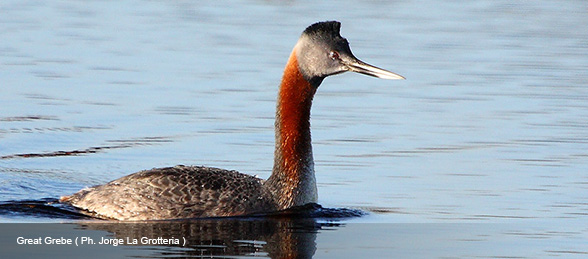
The Pampas grassland
This ecosystem shares many of the birds present in the others, but there are some species not findable anywhere else. In Buenos Aires most of these species are passerines (although some of the best representatives of the pampas are non-passerines, like the Greater Rhea and a couple of species of tinamous, which are now extinct in the city). Among the non passerines, some of the birds still possible to find in BA city or near it are the Long-winged Harrier, White-tailed Kite, Guira Cuckoo and Campo Flicker.
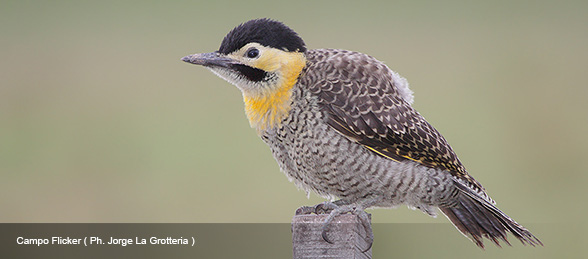
The list of passerines is long. Some of the emblematic pampas birds are very hard to find in the city, such as Hudson’s Canastero and Bay-capped Wren-spinetail (this last one also inhabits wetlands) or already extinct from the area, and endangered in all its distribution range, like the Pampas Meadowlark. Among the common pampas birds still findable in some of BA’s urban reserves are some summer visitors like the Fork-tailed Flycatcher, the colorful Vermilion Flycatcher and Double-collared Seedeater. Residents are many, such as the Great Pampa-finch, and the very common Saffron Finch, Grassland Yellow-Finch and Hooded Siskin. Blackbirds are common, such as the Screaming Cowbird, Shiny Cowbird, Bay-winged Cowbird and White-browed Blackbird.
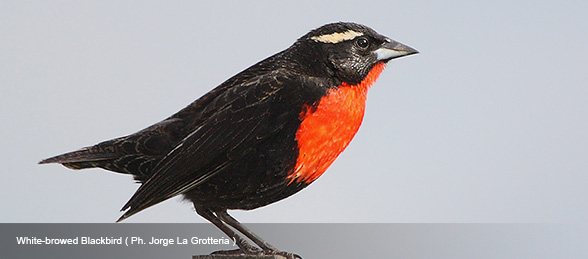
The Pampas grassland is the most endangered ecosystem in Argentina, therefore most of its endemic and symbolic species are endangered too.